Using my perfected master scone recipe, build your own scones with a variety of add-ins like chocolate chips, berries, or cheese and herbs. These better-than-the-bakery treats are flaky, flavorful, and moist with crisp crumbly edges. There’s a lot of helpful information and step-by-step photos, but feel free to jump right to the recipe!
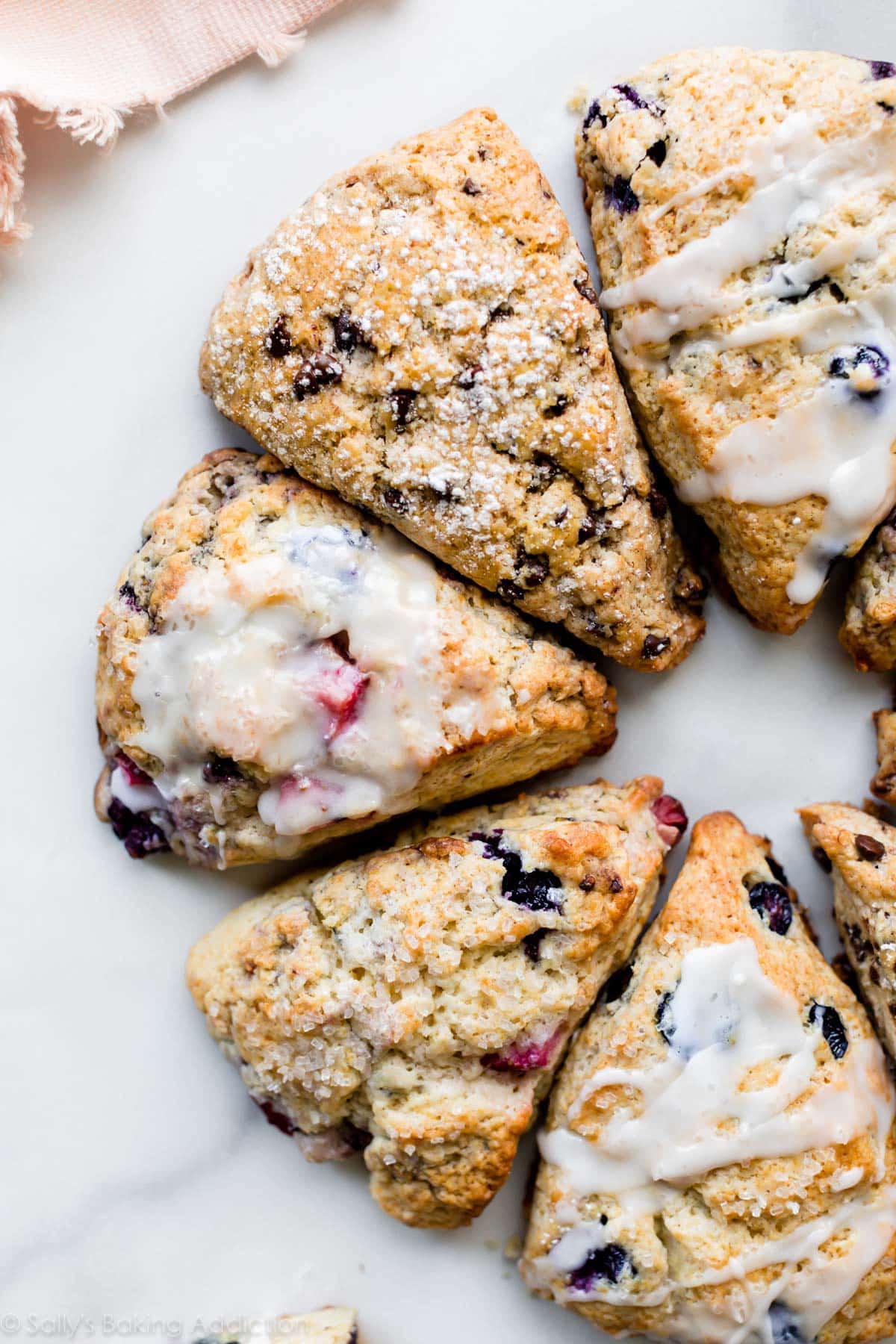
Scones are sweet or savory, perfect with coffee and tea, welcome at baby showers, bridal showers, brunch, snack time, bake sales, Mother’s Day, and wherever muffins or coffee are appropriate. (All the time!)
But depending on the recipe and technique, scones can be dry and sandpaper-y with flavor comparable to cardboard. They can also over-spread and taste pretty boring. However, boring isn’t in our scone vocabulary!! My basic scone recipe promises uniquely crisp and buttery scones with crumbly corners and a soft, flaky interior.
I have several scone recipes that begin with the same basic formula. Let’s review the fundamentals so you can learn how to make the best scones. Sit back because there’s a lot to cover in this post!
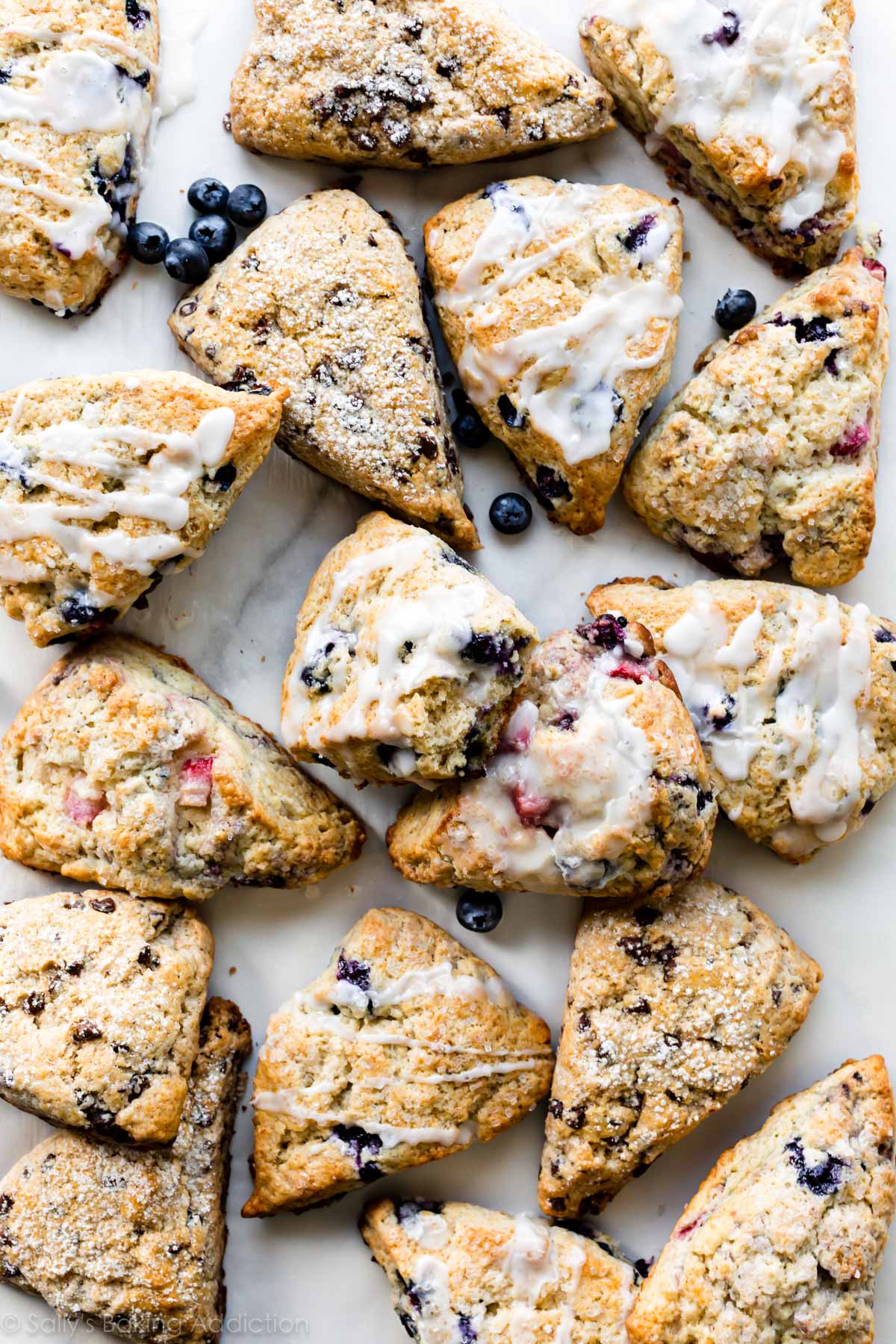
What are Scones?
Depending where you live, the term “scone” differs. English scones are more similar to American biscuits and they’re often topped with butter, jam, or clotted cream. American scones are different, but different isn’t necessarily a bad thing! Today’s scones are sweeter, heavier, and aren’t usually topped with butter because there’s so much butter IN them. Sweetness aside, there’s still room for vanilla icing or a dusting of confectioners’ sugar on top. By the way, here’s my favorite recipe for traditional scones.
Scones are leavened with baking powder, so making them is generally quick. Blueberry scones are my favorite variety, but that quickly switches to pumpkin scones in the fall months! (Here are all my scone recipes.)
No matter which flavor you choose, these scones are:
- Moist & soft inside
- Crumbly on the edges
- Buttery & flaky
- Not sandpapery 🙂
Video Tutorial: Scones
Let’s start with a video tutorial.
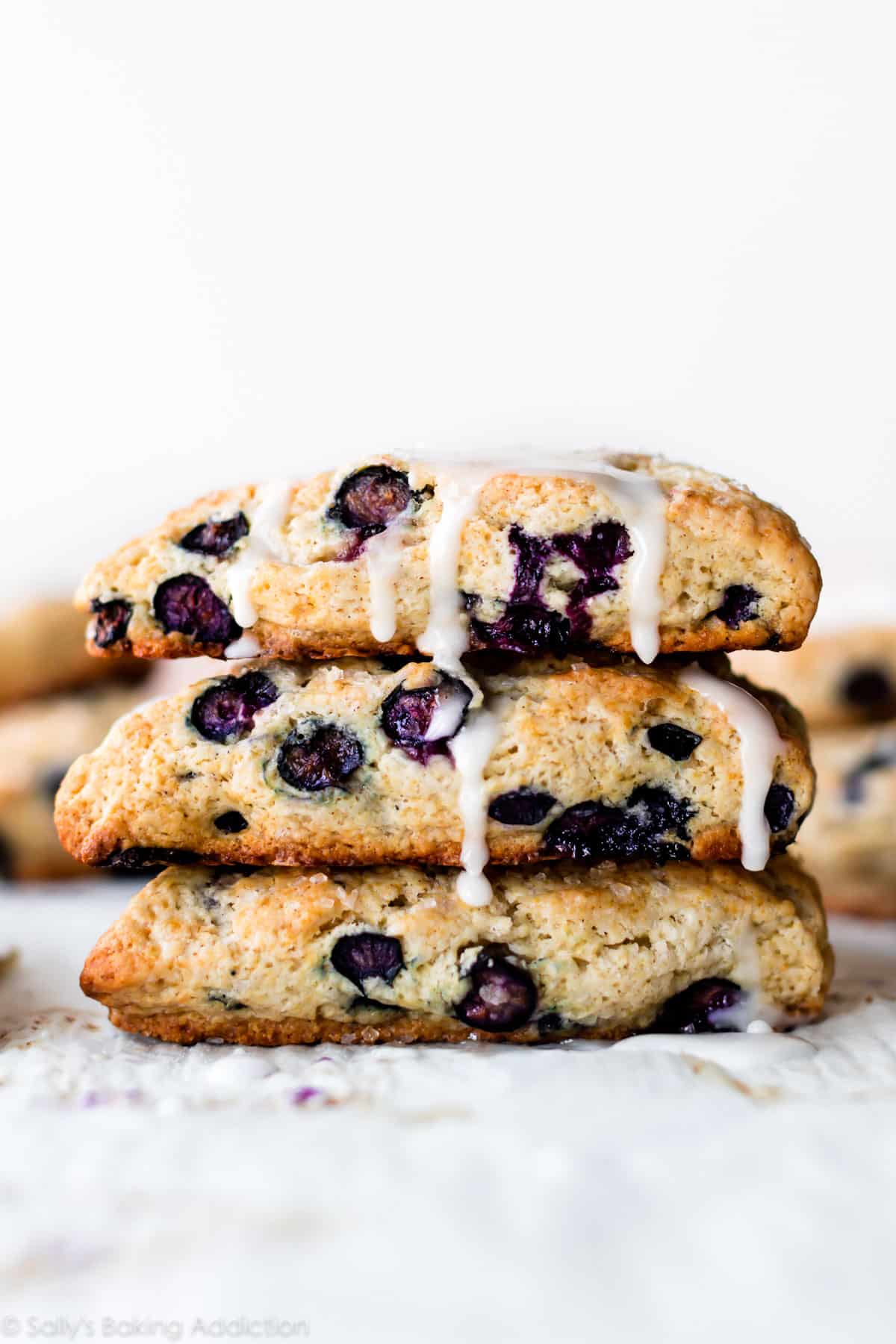
Only 7 Ingredients in this Basic Scone Recipe
You only need 7-9 ingredients for my master scone recipe.
- Flour: 2 cups of all-purpose flour is my standard amount, but set extra aside for the work surface and your hands.
- Sugar: I stick with around 1/2 cup of sugar for this scone dough. Feel free to slightly decrease, but keep in mind that the scone flavor and texture will slightly change. Reduce to about 2 Tablespoons for savory flavors. Brown sugar works too. However, if using brown sugar, whisk it into the wet ingredients to get out all the lumps. For example, see my caramel apple scones.
- Baking Powder: Adds lift.
- Salt: Adds flavor.
- Butter: Besides flour, butter is the main ingredient in scones. It’s responsible for flakiness, flavor, crisp edges, and rise.
- Heavy Cream or Buttermilk: For the best tasting pastries, stick with a thick liquid such as heavy cream or buttermilk. I usually use heavy cream, but if you want a slightly tangy flavor, use buttermilk. Thinner liquids change the flavor and appearance. You’ll be headed down a one way street to dry, bland, and flat scones.
- Egg: Adds flavor, lift, and structure.
- Optional: Vanilla extract adds necessary flavor to sweet scones, but skip it if you’re making savory scones. Depending on the flavor, cinnamon is another go-to ingredient.
And don’t forget about the add-ins! Scroll down to see all my favorite scone flavors.
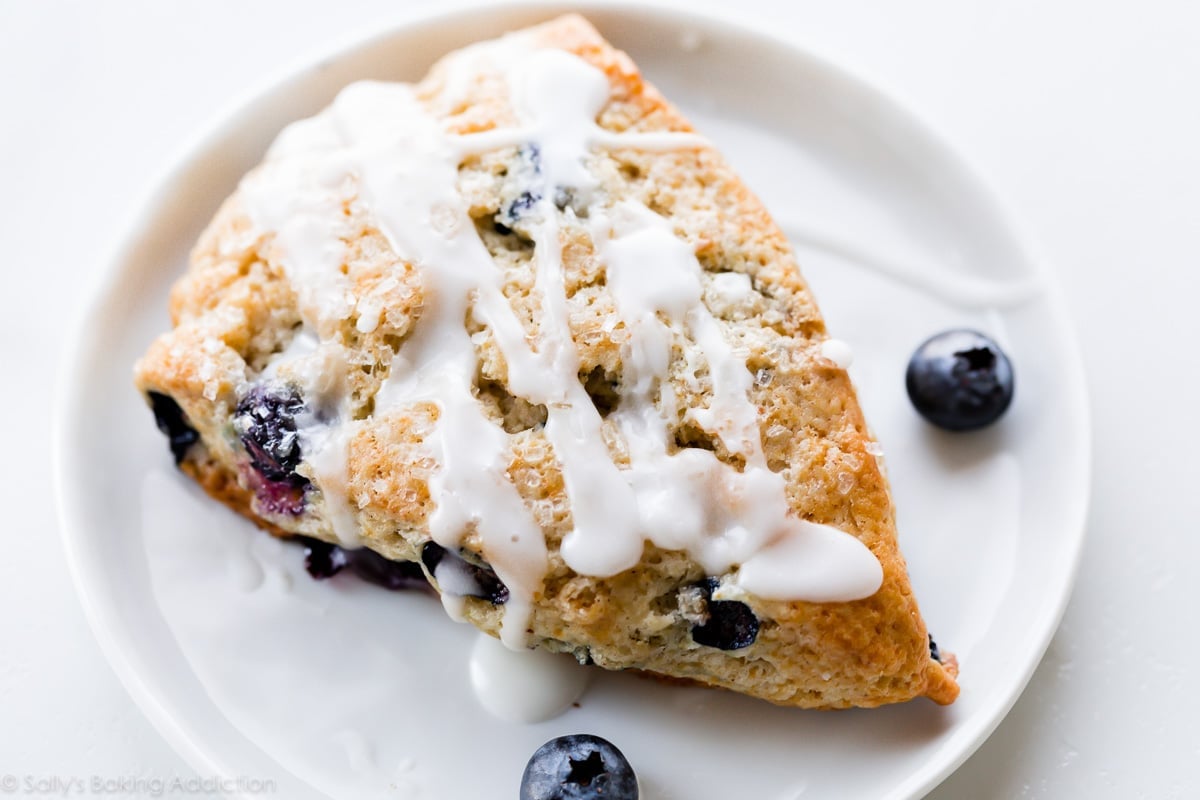
How to Make Scones from Scratch
So now that you understand which ingredients are best, let’s MAKE SCONES!
- Mix the dry ingredients together. Use a big mixing bowl because you want lots of room for the mixing process.
- Cut in the grated frozen butter. You can use a pastry cutter or 2 forks, like we do with pie crust, or your hands. A food processor works too, but it often overworks the scone dough. To avoid overly dense scones, work the dough as little as possible. Messy and crumbly is a good thing!
- Whisk the wet ingredients together.
- Mix wet ingredients and dry ingredients. Mix together, then pour out onto the counter.
- Form into a disc and cut into wedges. Wedges are easiest, but you can make 10-12 drop scones like I do with my banana scones.
- Brush with heavy cream or buttermilk. For a golden brown, extra crisp and crumbly exterior, brush with liquid before baking. And for extra crunch, a sprinkle of coarse sugar is always ideal!
- Refrigerate for at least 15 minutes. Keep scone dough as cold as possible. To avoid over-spreading, I recommend chilling the shaped scones for at least 15 minutes in the refrigerator before baking. In fact, you can even refrigerate overnight for a quick breakfast in the morning!
- Bake until golden brown. Scones bake in a relatively hot oven for only 20-25 minutes.
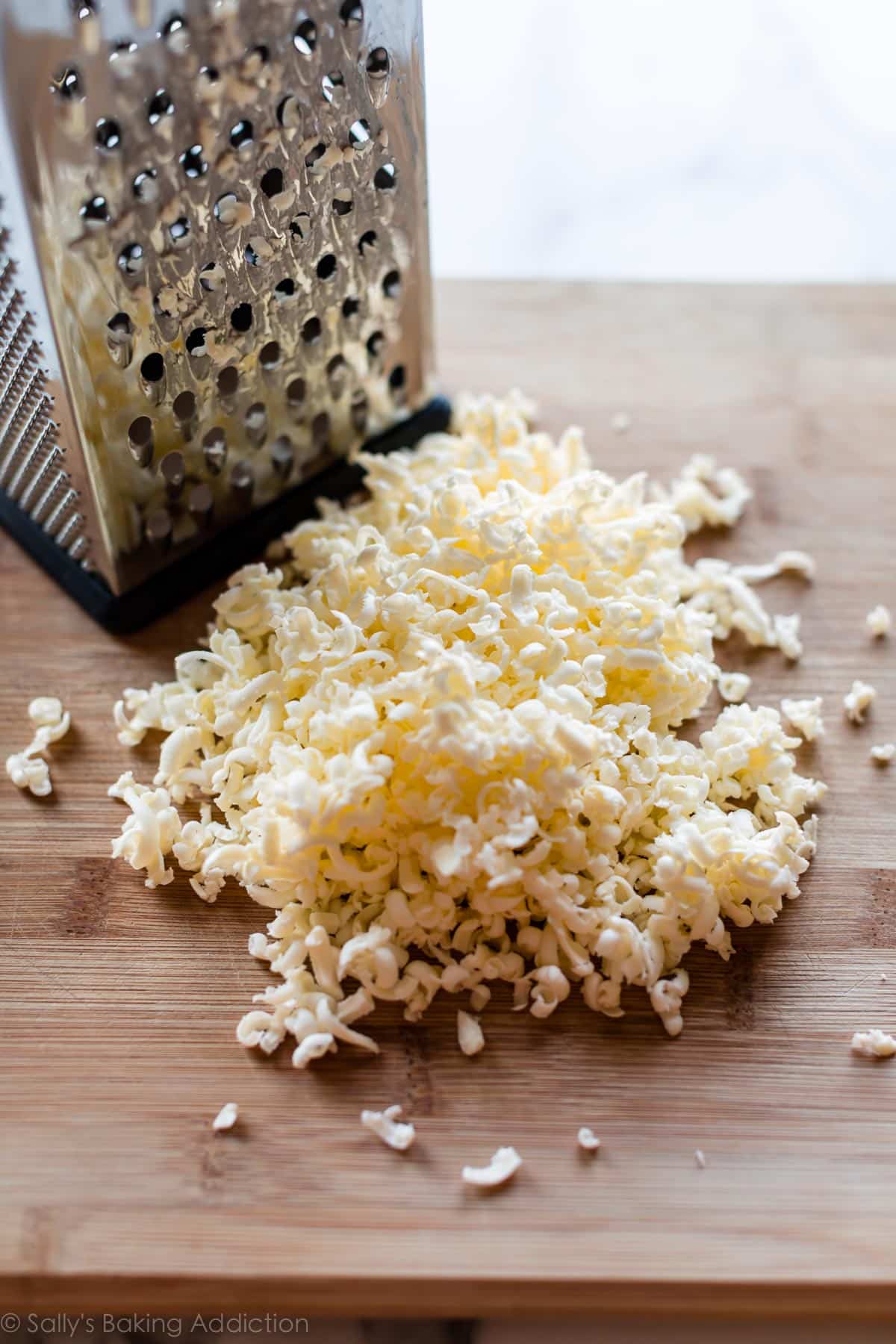
Cold Ingredients & Frozen Grated Butter
Keeping scone dough as cold as possible prevents over-spreading. When scones over-spread in the oven, they lose the flaky, moist, and deliciously crumbly texture. In other words, they’re ruined. But the easiest way to avoid disaster is to use cold ingredients like cold heavy cream, egg, and butter.
But frozen grated butter is the real key to success.
Like with pie crust, work the cold butter into the dry ingredients to create crumbs. The butter/flour crumbs melt as the scones bake, releasing steam and creating air pockets. These pockets create a flaky center while keeping the edges crumbly and crisp. Refrigerated butter might melt in the dough as you work with it, but frozen butter will hold out until the oven. And the finer the pieces of cold butter, the less the scones spread and the quicker the butter mixes into the dry ingredients. Remember, you don’t want to over-work scone dough.
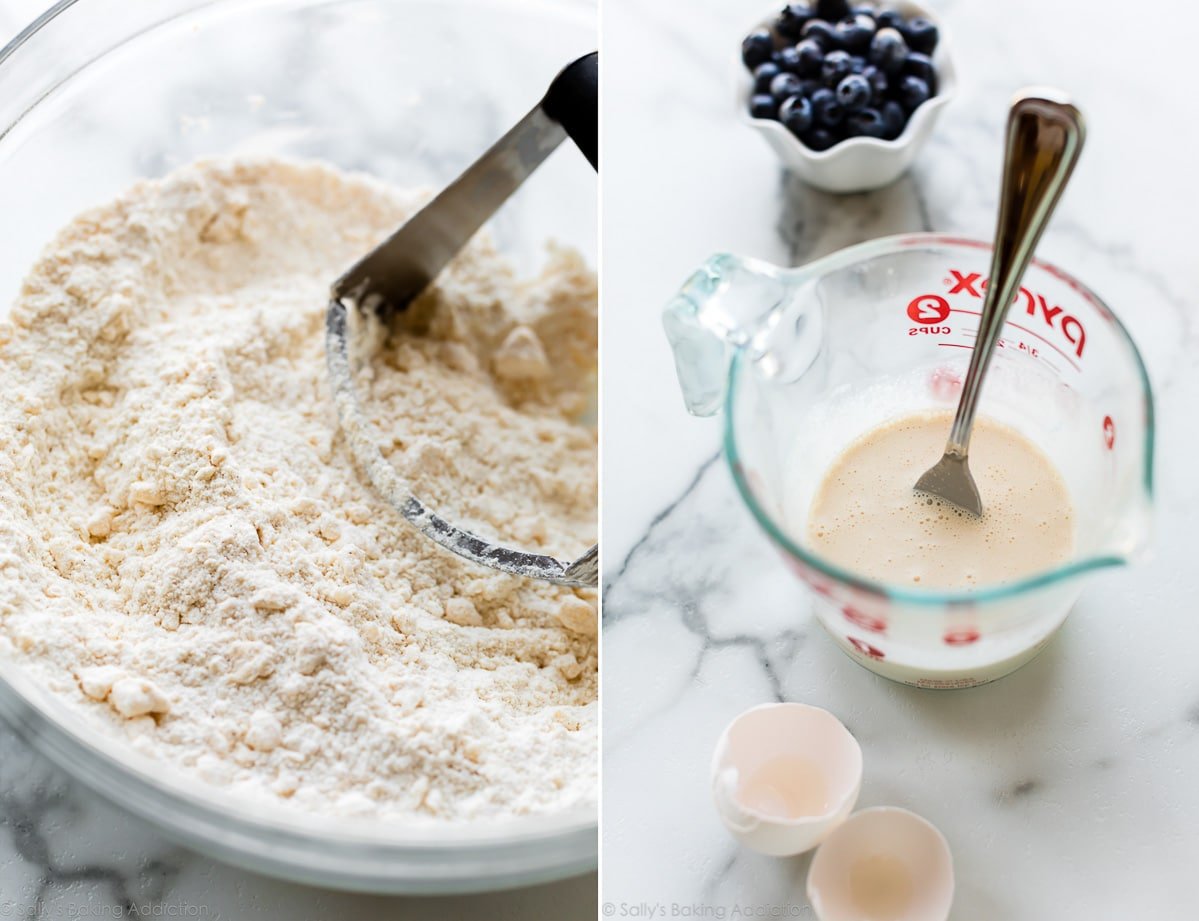
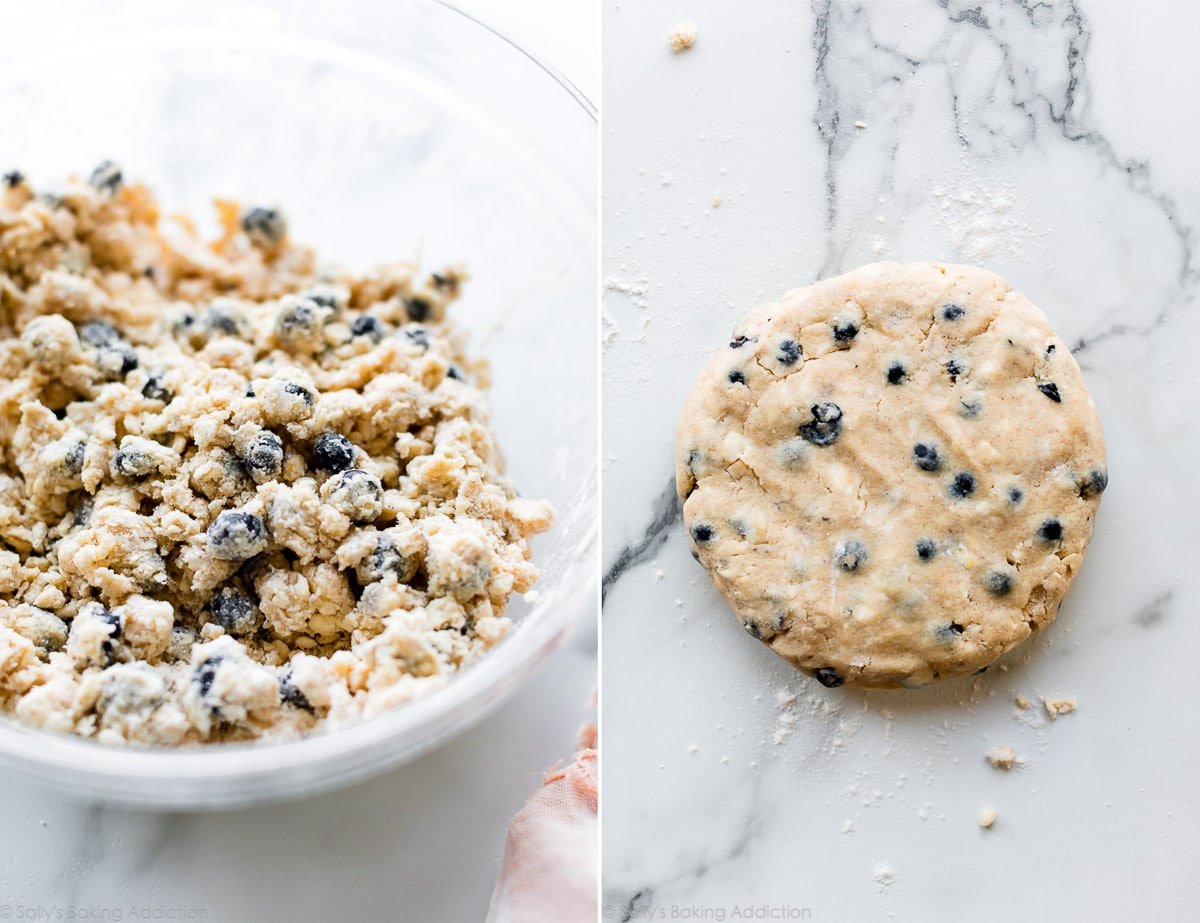
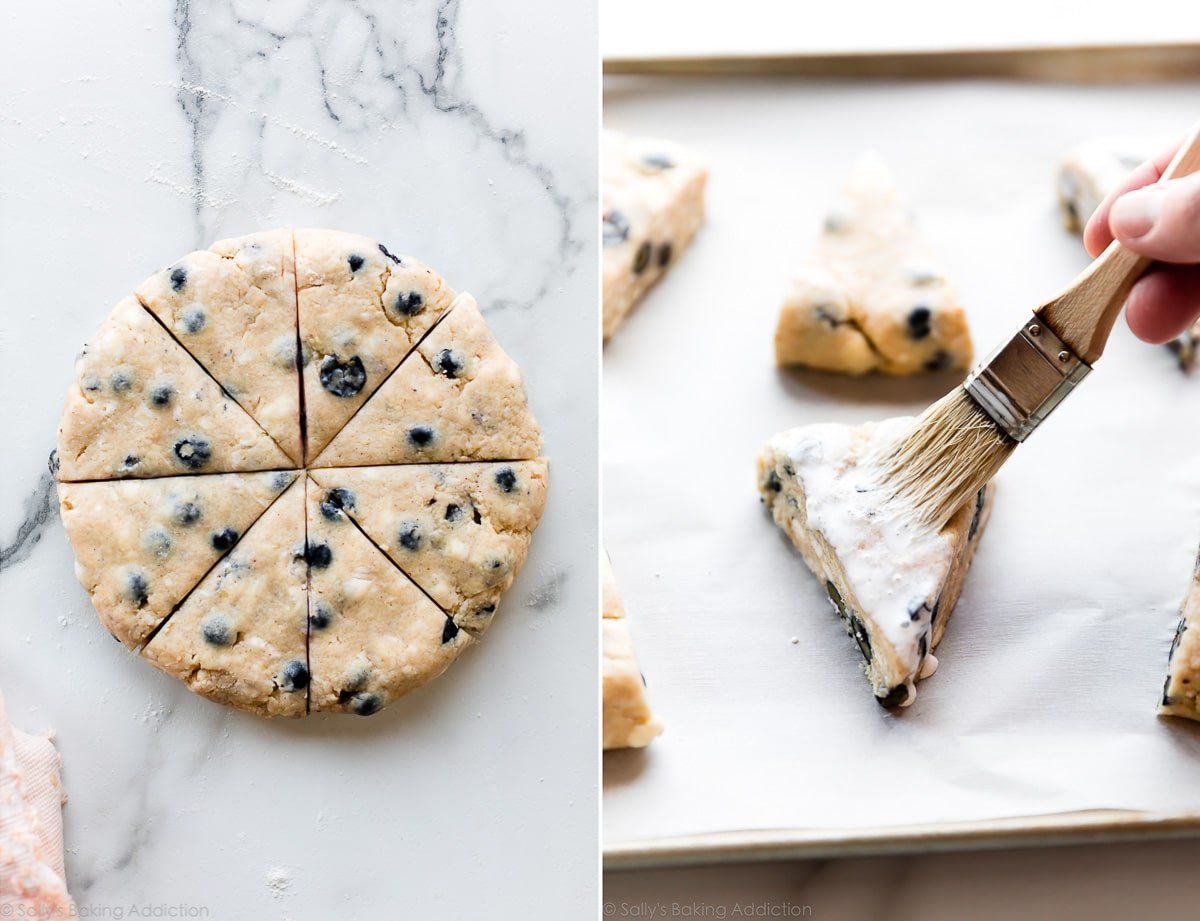
3 Tricks for Perfect Scones
If you take away anything from this post, let these be it!
- Heavy Cream or Buttermilk: Avoid thinner milks which yield a flatter, less flavorful scone. Canned coconut milk makes a wonderful nondairy option!
- Frozen Grated Butter: See above!
- Refrigerate Before Baking: Remember, cold dough is a successful dough. To avoid over-spreading, I recommend chilling the shaped scones for at least 15 minutes in the refrigerator before baking.
How to prevent flat scones: See #2 and #3. 🙂
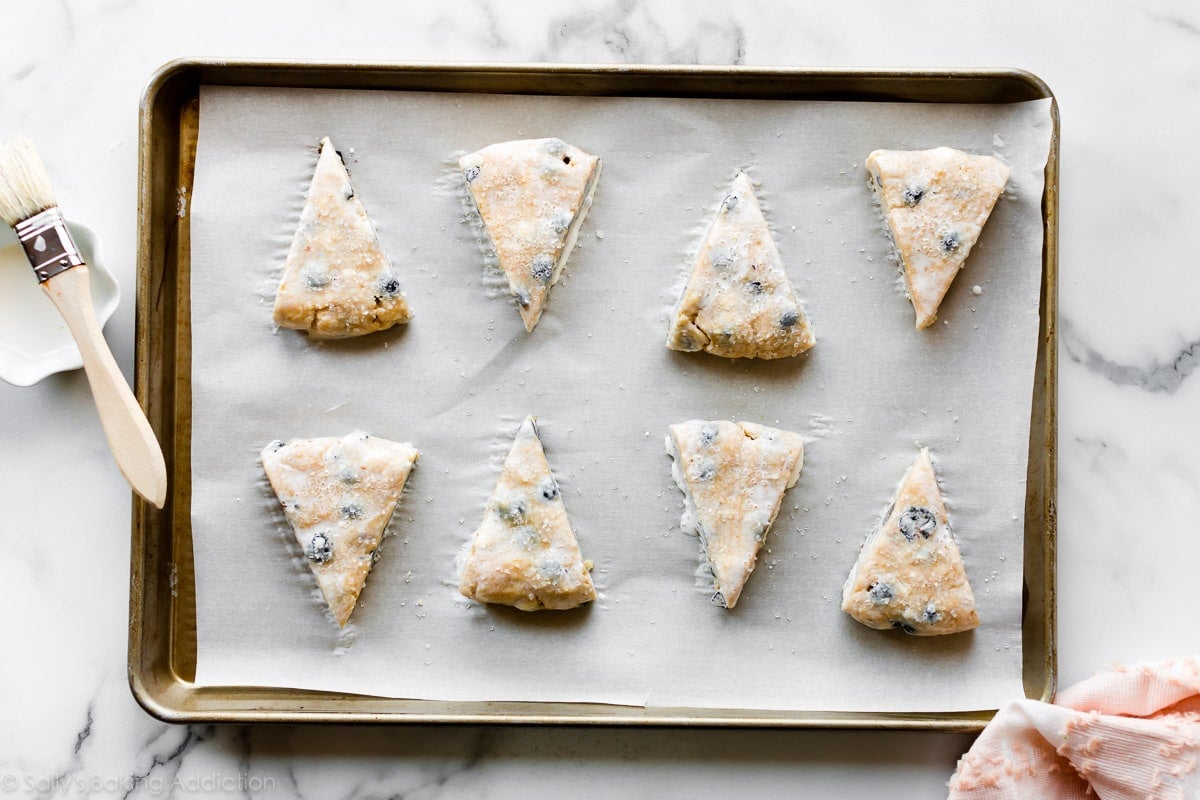
How to Freeze Scones
I used to be totally against freezing scone dough. You see, the baking powder is initially activated once wet and if you hold off on baking, the scones won’t rise as much in the oven. However, the decrease in rise is so slight that it doesn’t make a noticeable difference. In fact, you can even shape this scone dough into wedges and refrigerate overnight before baking.
- Freeze Before Baking: Freeze scone dough wedges on a plate or baking sheet for 1 hour. Once relatively frozen, you can layer them in a freezer-friendly bag or container. Bake from frozen, adding a few minutes to the bake time in the recipe below. Or thaw overnight, then bake as directed.
- Freeze After Baking: Freeze the baked and cooled scones before topping with icing or confectioners’ sugar. I usually freeze in a freezer-friendly bag or container. To thaw, leave out on the counter for a few hours or overnight in the refrigerator. Warm in the microwave for 30 seconds or on a baking sheet in a 300°F (149°C) oven for 10 minutes.
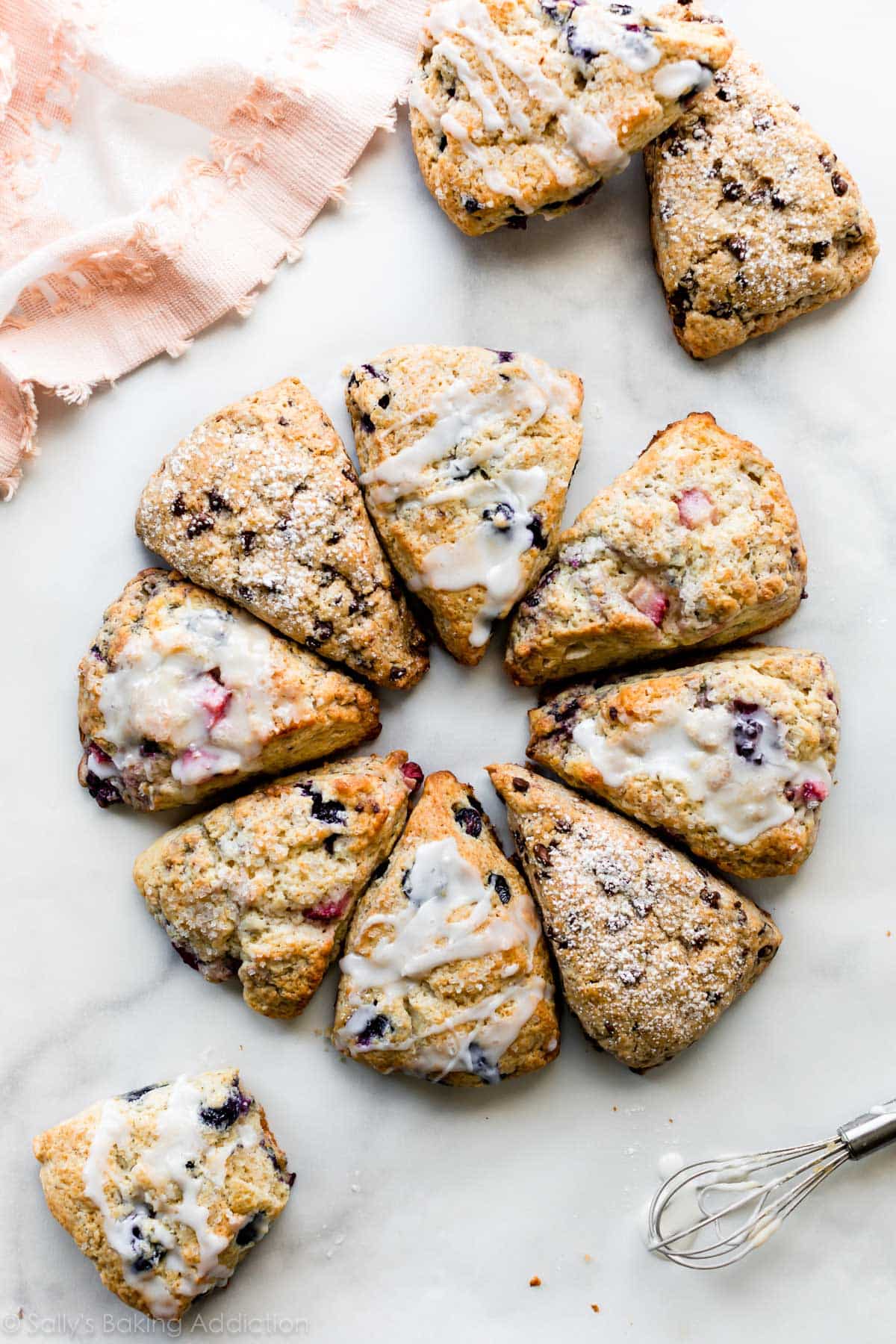
15+ Scone Flavors
- Blueberry Scones and Chocolate Chip Scones (both pictured)
- Cranberry Orange and Pumpkin Scones
- Banana Scones and Lavender Scones
- Lemon Blueberry Scones and Sprinkle Scones
- Caramel Apple and Cinnamon Chip Scones
- Triple Chocolate Scones – they taste like brownies!
- Strawberry Lemon Poppy Seed Scones
- Ham & Cheese Scones
- Mixed Berry (pictured): Follow recipe below and add fresh or frozen mixed berries. Raspberries and blackberries burst easily, so don’t go overboard on those.
- Cherry Chocolate Chip: Follow recipe below and add 3/4 cup semi-sweet chocolate chips and 3/4 cup chopped fresh or frozen cherries.
- Raspberry Almond: Follow the recipe below and add 1/2 teaspoon of almond extract with the vanilla. After shaping the scones, gently press frozen raspberries into each, using about 1 cup total. (Avoid mixing them into the dough, as they can bleed.) Top the shaped scones with sliced almonds before baking (1/3 cup / 37g total almonds). After baking, drizzle with the raspberry icing from these mini vanilla pound cakes.
- Fresh Herb: Reduce sugar to 2 Tablespoons, leave out vanilla extract, and add 2 minced garlic cloves, 1/2 teaspoon ground black pepper, 1/2 cup chopped herbs such as rosemary, parsley, and basil. Additionally, feel free to add 1 cup shredded cheese to the dough and top with sea salt before or after baking!
Using the master recipe below as a starting point, toss in your favorite add-ins like white chocolate chips, toasted pecans, sweetened or unsweetened coconut, dried cranberries, peanut butter chips, etc. If it’s a particularly wet add-in like chopped peaches, blot them with a paper towel before adding to the dough. Top with lemon curd, raspberry sauce, or any of the suggested toppings below. Above all, have fun finding your favorite flavor!
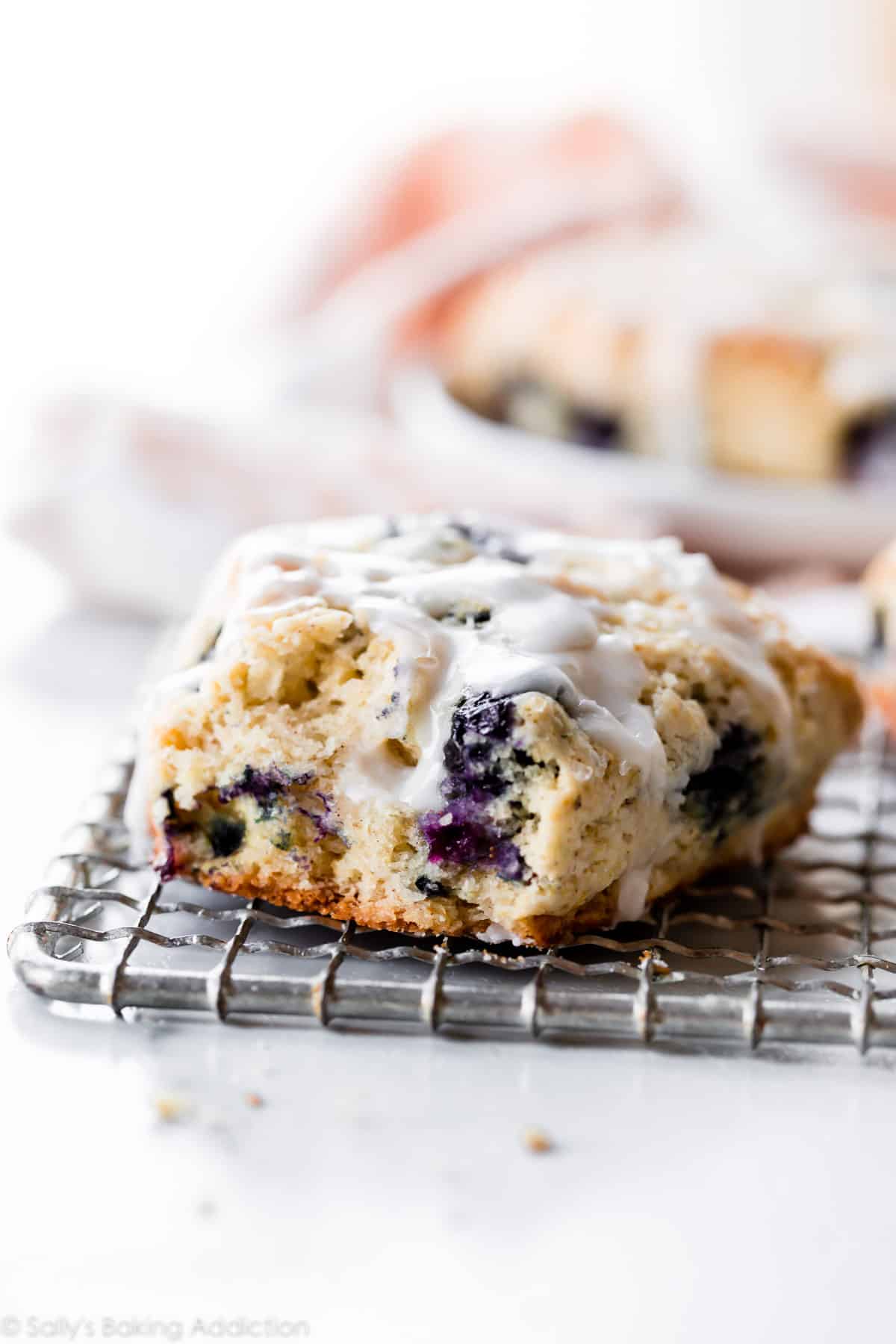
Look At All Of Your Scones!
Feel free to email or share your recipe photos with us on social media. 🙂
Print
How to Make Perfect Scones
- Prep Time: 30 minutes
- Cook Time: 25 minutes
- Total Time: 1 hour
- Yield: 8 large or 16 small scones
- Category: Breakfast
- Method: Baking
- Cuisine: American
Description
Use this basic scone dough for any sweet scone variety. See blog post for a couple savory scone options. Feel free to increase the vanilla extract and/or add other flavor extracts such as lemon extract or coconut extract. Read through the recipe before beginning. You can skip the chilling for 15 minutes prior to baking, but I highly recommend it to prevent the scones from over-spreading.
Ingredients
- 2 cups (250g) all-purpose flour (spooned & leveled), plus more for hands and work surface
- 1/2 cup (100g) granulated sugar
- 1/2 teaspoon salt
- 2 and 1/2 teaspoons baking powder
- 1/2 cup (1 stick; 115g) unsalted butter, frozen
- 1/2 cup (120ml) heavy cream or buttermilk (plus 2 Tbsp for brushing)
- 1 large egg
- 1 and 1/2 teaspoons pure vanilla extract
- 1–1.5 cups add-ins such as chocolate chips, berries, nuts, fruit, etc
- optional: coarse sugar for topping
Instructions
- Whisk flour, sugar, salt, and baking powder together in a large bowl. Grate the frozen butter using a box grater. Add it to the flour mixture and combine with a pastry cutter, two forks, or your fingers until the mixture comes together in pea-sized crumbs. See video above for a closer look at the texture. Place in the refrigerator or freezer as you mix the wet ingredients together.
- Whisk 1/2 cup heavy cream, the egg, and vanilla extract together in a small bowl. Drizzle over the flour mixture, add the add-ins, then mix together until everything appears moistened.
- To make triangle scones: Pour onto the counter and, with floured hands, work dough into a ball as best you can. Dough will be sticky. If it’s too sticky, add a little more flour. If it seems too dry, add 1-2 more Tablespoons heavy cream. Press into an 8-inch disc and, with a sharp knife or bench scraper, cut into 8 wedges. For smaller scones, press dough into two 5-inch discs and cut each into 8 wedges. To make 10-12 drop scones: Keep mixing dough in the bowl until it comes together. Drop scones, about 1/4 cup of dough each, 3 inches apart on a lined baking sheet. To make mini (petite) scones, see recipe note.
- Brush scones with remaining heavy cream and for extra crunch, sprinkle with coarse sugar. (You can do this before or after refrigerating in the next step.)
- Place scones on a plate or lined baking sheet (if your fridge has space!) and refrigerate for at least 15 minutes.
- Meanwhile, preheat oven to 400°F (204°C).
- Line a large baking sheet with parchment paper or silicone baking mat(s). If making mini or drop scones, use 2 baking sheets. After refrigerating, arrange scones 2-3 inches apart on the prepared baking sheet(s).
- Bake for 18-26 minutes or until golden brown around the edges and lightly browned on top. Larger scones take closer to 25 minutes. Remove from the oven and cool for a few minutes. Feel free to top with any of the toppings listed in the recipe Note below.
- Leftover scones keep well at room temperature for 2 days or in the refrigerator for 5 days.
Notes
- Freeze Before Baking: Freeze scone dough wedges on a plate or baking sheet for 1 hour. Once relatively frozen, you can layer them in a freezer-friendly bag or container. Bake from frozen, adding a few minutes to the bake time in the recipe below. Or thaw overnight, then bake as directed.
- Freeze After Baking: Freeze the baked and cooled scones before topping with icing or confectioners’ sugar. I usually freeze in a freezer-friendly bag or container. To thaw, leave out on the counter for a few hours or overnight in the refrigerator. Warm in the microwave for 30 seconds or on a baking sheet in a 300°F (149°C) oven for 10 minutes.
- Overnight Instructions: Prepare scones through step 4. Cover and refrigerate overnight. Continue with the recipe the following day.
- Special Tools (affiliate links): Glass Mixing Bowls | Box Grater | Pastry Cutter | Whisk | Rubber Spatula | Bench Scraper | Baking Sheet | Silicone Baking Mat or Parchment Paper | Pastry Brush
- Scone Flavors: See blog post above. If adding fruit, use fresh or frozen. If frozen, do not thaw. Peel fruits such as apples, peaches, or pears before chopping. If desired, add 1 teaspoon of cinnamon with the flour. I usually add cinnamon when making chocolate chip scones.
- Over-spreading: Start with very cold scone dough. Expect some spread, but if the scones are over-spreading as they bake, remove from the oven and press back into its triangle shape (or whatever shape) using a rubber spatula.
- Mini/Petite Scones: To make smaller scones, press dough into two 5-inch discs and cut each into 8 equal wedges. Bake for 18-20 minutes or until lightly browned.
- Optional Toppings: Vanilla icing, salted caramel, lemon icing from this iced lemon pound cake, maple icing from these banana scones, brown butter icing from these pistachio cookies, lemon curd, orange icing from these hot cross buns, raspberry icing from these mini pound cakes, dusting of confectioners’ sugar.
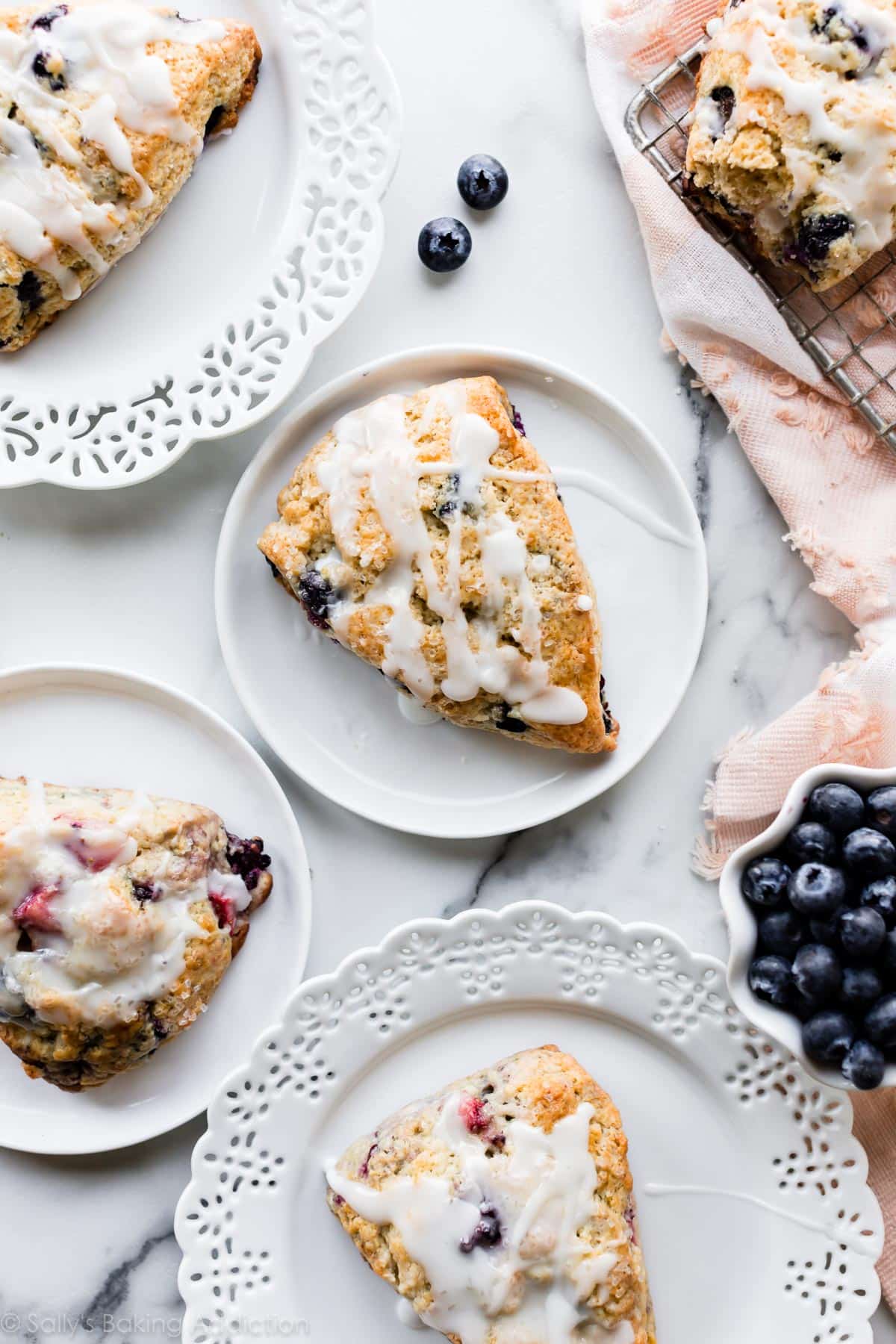
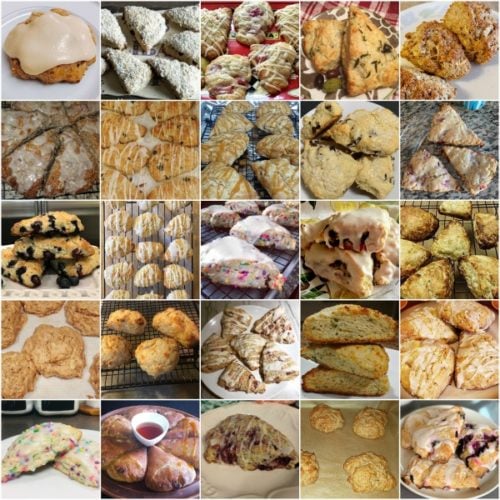
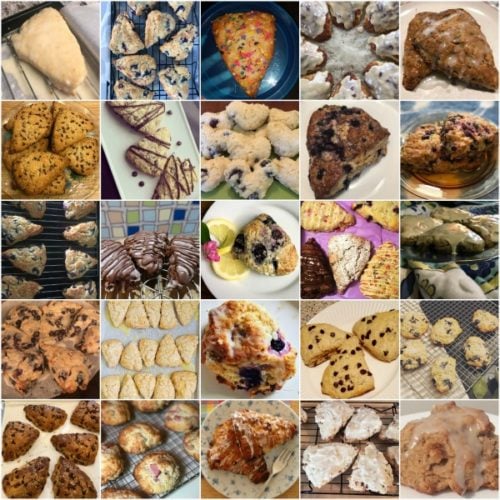
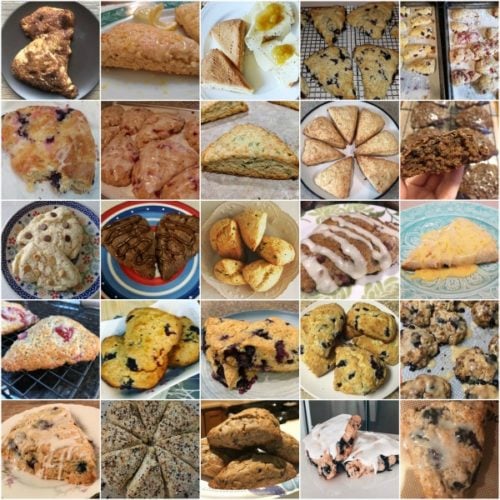
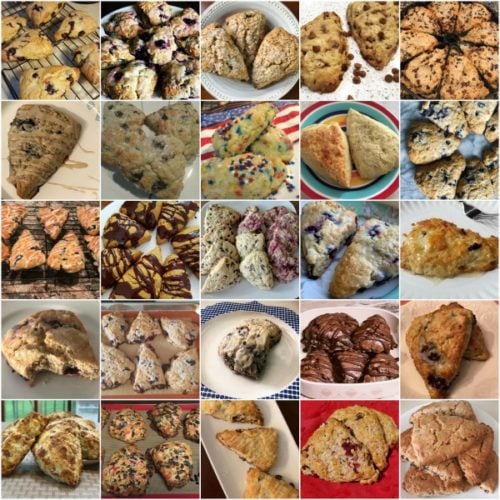

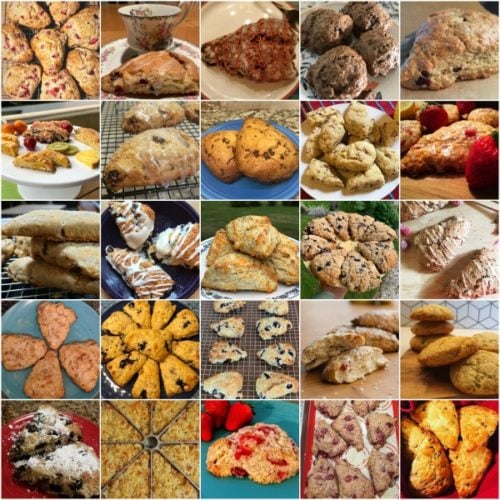
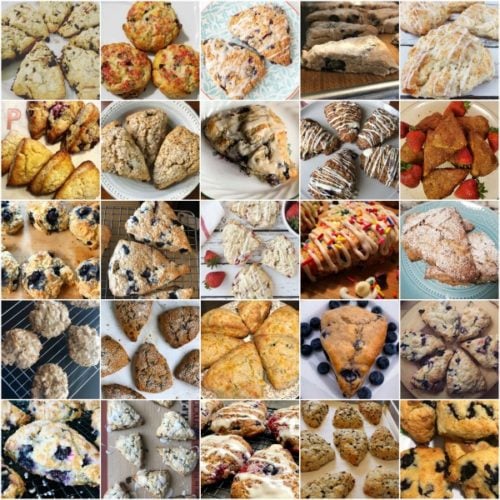
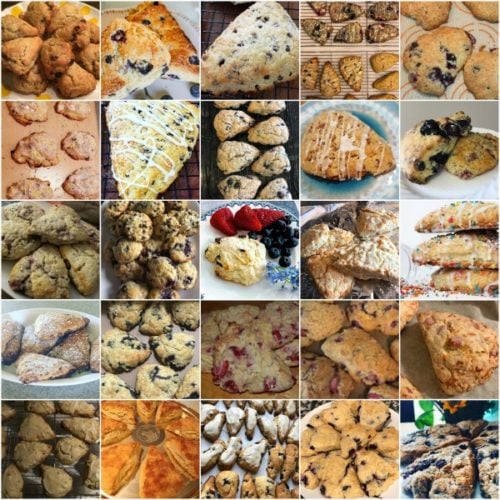
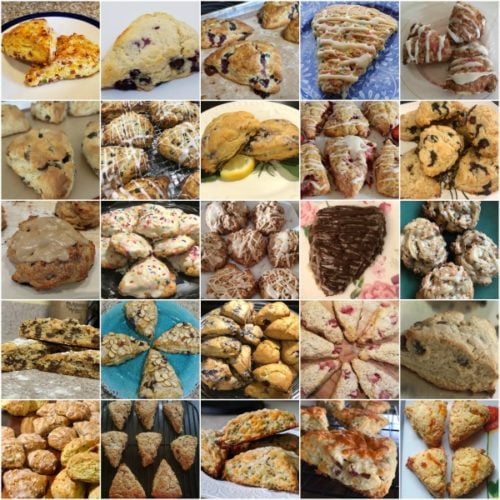
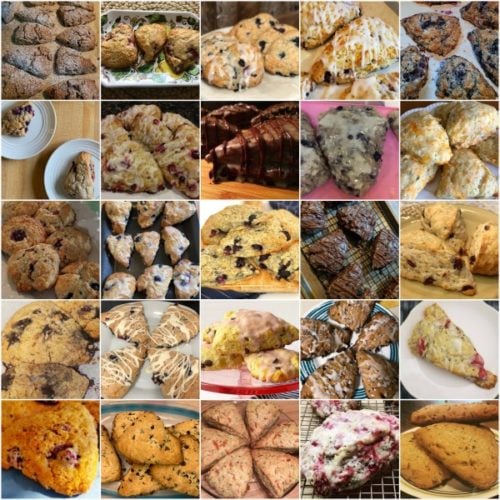
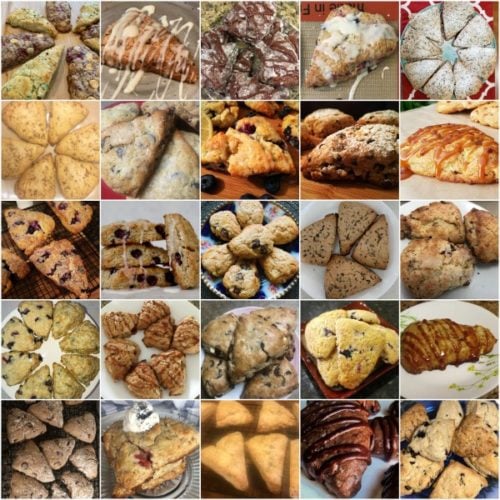
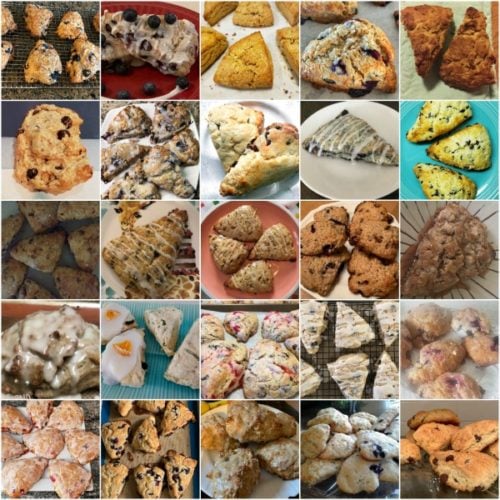
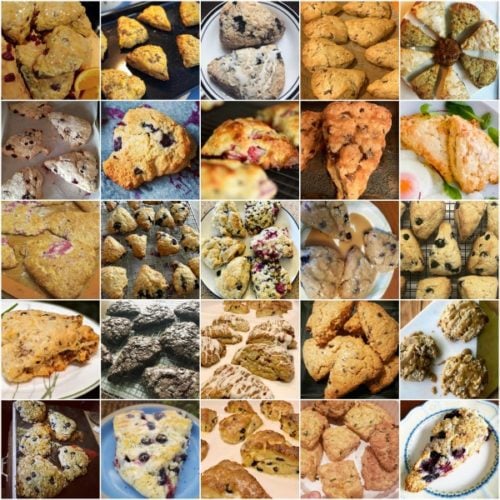
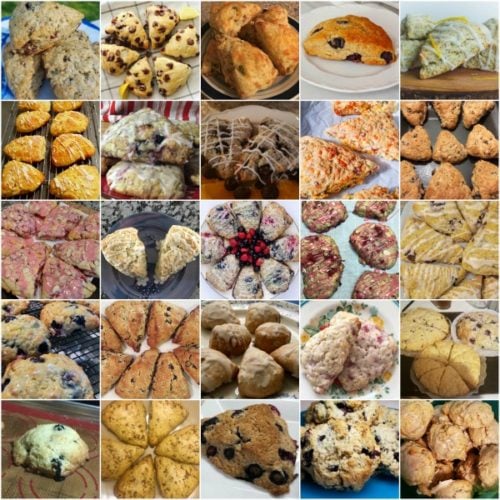
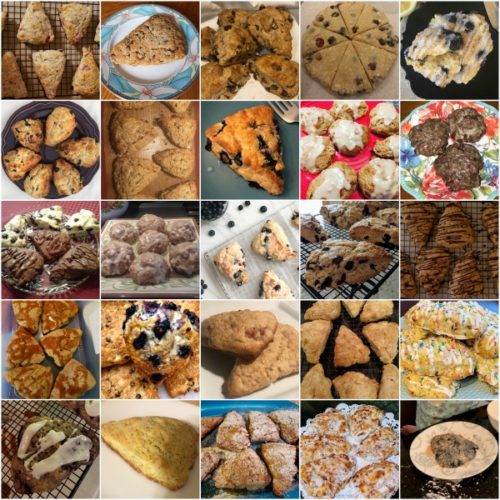
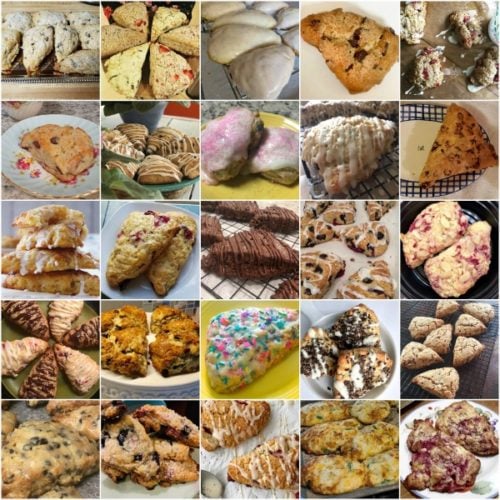
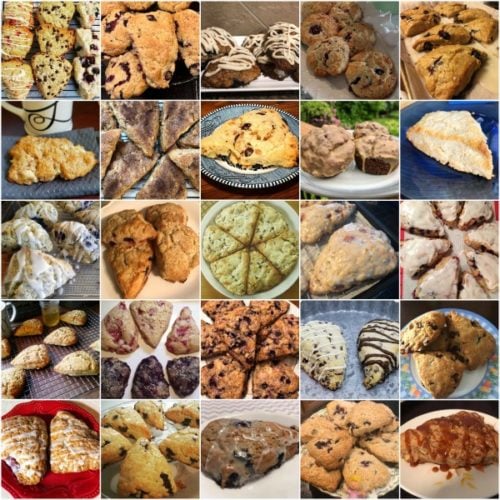
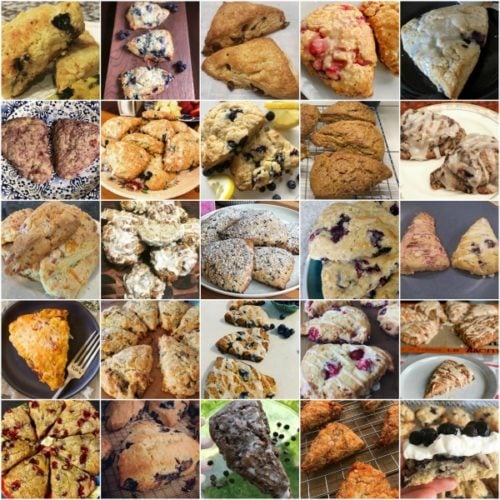
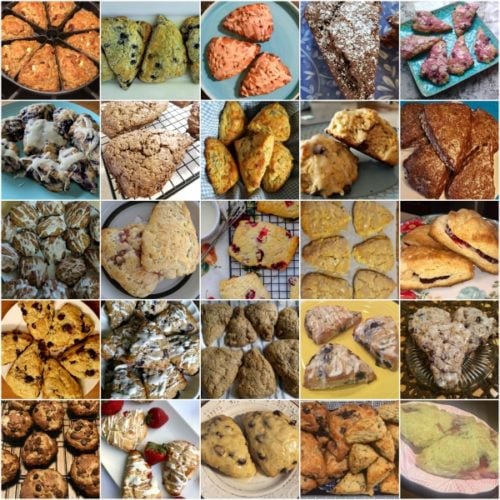
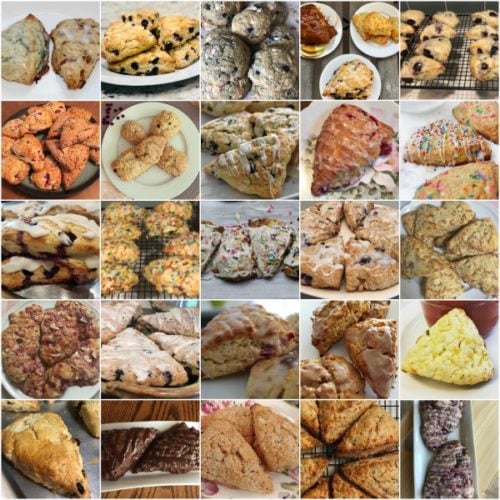
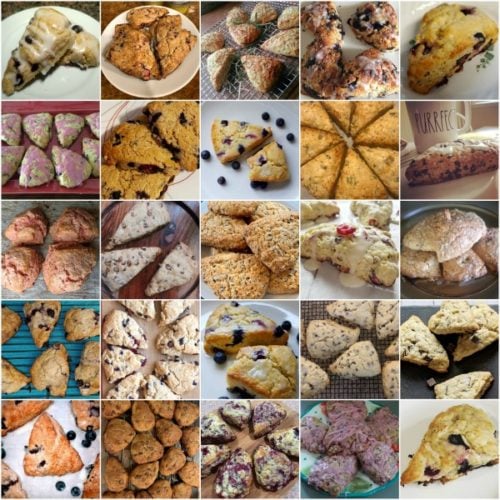

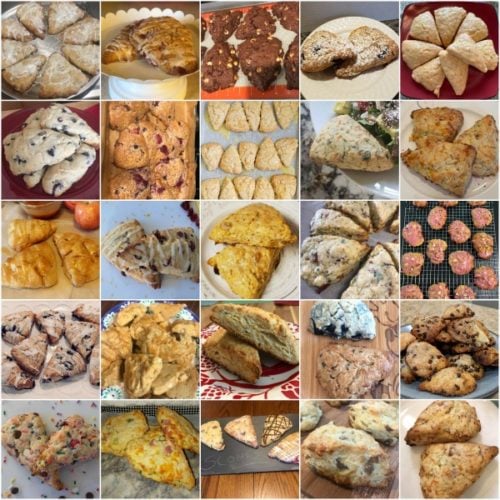
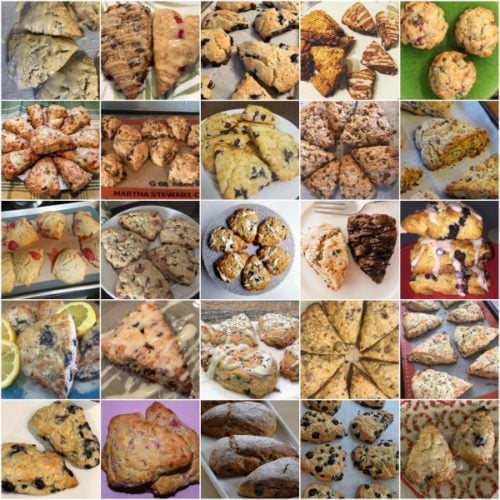
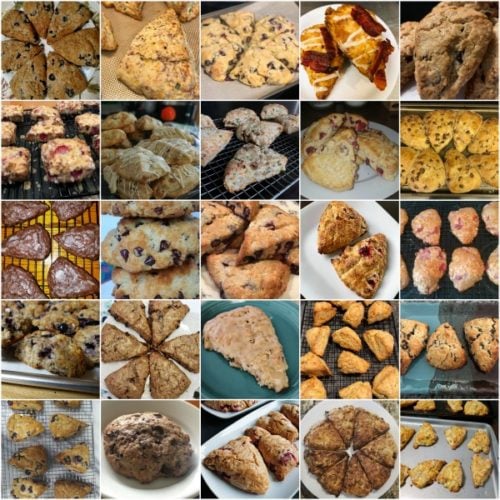
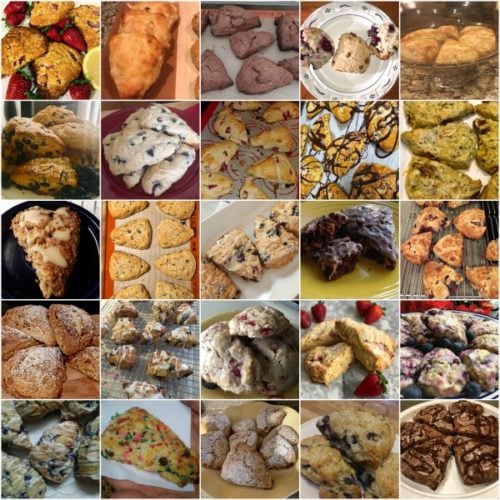
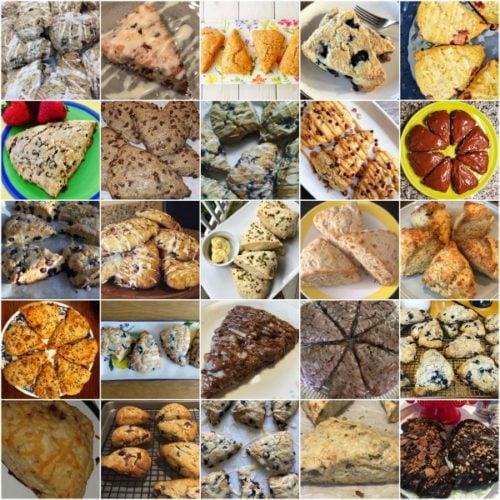
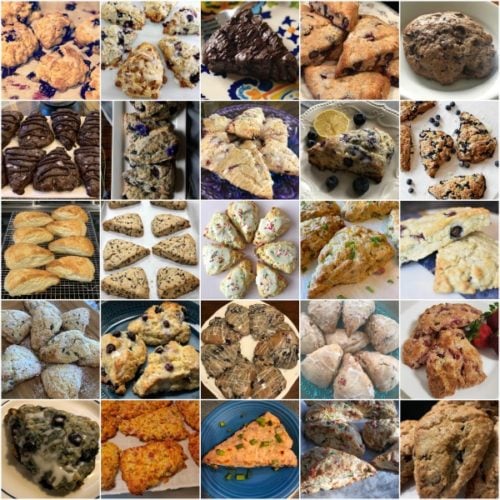



















Perfect scones! I made white chocolate raspberry scones using a cup of raspberries and a half cup of white chocolate chips. I made a simple glaze for the top with vanilla, cream, and powdered sugar. These scones are delightfully sweet and honestly some of the best I’ve ever had. Thanks for such an awesome master recipe. I used to be intimidated by scones and now I can’t wait to try every flavor imaginable.
Excellent scones! I made them with dark chocolate chips and orange zest and treated my landscapers. They were gobbled up immediately.
Adding this to my pinterest! Oh goodness, this might be the perfect scone recipe. My hubby and I scarfed them down. I made clotted cream with it and it was like we were transported back to London. Thank you so much, Sally!
This recipe was wonderful and I am make a large verity for my wife and daughters tea at church on Sunday!
Great basic recipe! I made two batches. The Garlic, Herb, and Cheddar were perfect! The Triple Berry was a very wet dough and did spread a bit, I think I might cut out just a bit of the cream since I used fresh blueberry, raspberry, blackberry mix ins. Will keep this as my go to scone following rave reviews at a Tea Party!
Can you use sourdough starter instead of baking powder?
We haven’t tested a sourdough version of these scones. For best taste and texture (and so you don’t waste your time trying to adapt this recipe since it may not work properly), it may be more useful to find a scone recipe that is specifically formulated for sourdough starter. Thank you!
This is truly the best, simple, and versatile scone recipe! If you grate very cold butter then put it in the freezer for about 15 min it is much easier to toss with dry ingredients as opposed to cutting it in. Brushing tops with heavy cream adds a nice crunch on the outside while keeping the inside moist and light. Delicious!!
I love this recipe, I get so many compliments on these scones everyone loves them! They are a great balance of sweetness and not dry like most scone recipes!
Hi Sally! I love this recipe.
I wonder if I make this as Gluten free ( using gluten free flour) and using egg substitute (flax or applesauce, will it make a difference?
Hi Sam! We haven’t tested it, but other readers have reported success using gluten free flour substitutes in this recipe. We also haven’t tested any egg substitutes.
Can I spread or fold in almond paste to each triangle?
Hi Donna! We haven’t tested that, but it sounds delicious.
I made blueberry scones and they were GREAT! And easy. And I’m not a cook (hubby does most of it). Question: he likes cherries. When they aren’t in season, can I use cherry pie filling? If so, how? Thanks. Glad I found you!
Hi Carolyn, so glad you enjoyed them! We wouldn’t add cherry pie filling to scones, it’s much too wet. If you can find frozen cherries during the off-season, you could add those frozen and chopped to these scones!
Thank you for this recipe! Nice and easy. I would strongly recommend using a stand cheese grater to grate the butter. Unwrap the butter most of the way and use the wrapper to hold it as you start it into the grater top. Crank away, and you can grate the butter with minimal mess. (I hate box graters, I can never use them with out losing skin off my knuckles.) I used Greek yogurt instead of cream or buttermilk, seemed to work well. So far I have done orange and white chocolate (just a little OJ concentrate and white chocolate chips) and dark chocolate raspberry. Also, instead of using flour to handle the dough, I coat my hands in coconut oil.
Can this recipe be doubled?
Hi RJJ, for best results and to prevent over or underworking the dough, we recommend making 2 separate batches rather than doubling.
I am planning a ladies tea and wanted to make scones. What do you suggest for smaller scones? Can i just roll out the dough and instead of cutting into 8 , use a smaller round cookie cutter?
Hi Kathy Jo, you can follow the shaping directions from these sprinkle scones for mini scones. Hope they’re a hit!